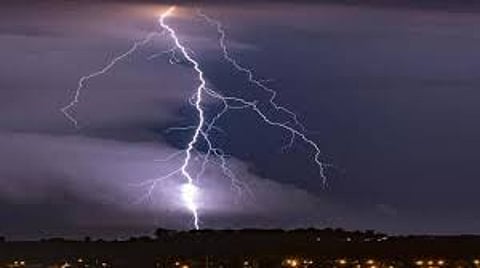

#Ajayan
Kochi | Dark evenings and thunder and lightning were a feature of the northeast monsoon or post-monsoon rains, called Thulavarsham in Malayalam. However, it seems this scenario has changed since lightning and thunder have become highly prevalent even during the southwest monsoon. A classic case is the occurrence of 61,000 lightning strikes in Odisha in two hours last week, claiming 12 lives. This raises significant concern over rising cases of lightning and thunderstorms across the country over the years.
A study ‘Variability in lightning hazard over Indian region with respect to El Niño–Southern Oscillation (ENSO) phases’ by AV Sreenath, S Abhilash and P Vijaykumar of the department of atmospheric sciences of Cochin University of Science and Technology makes clear why this rise in the lightning phenomenon.
Lightning is an electric discharge which is the result of imbalances between storm clouds and the ground. It can also occur within clouds or between the cloud and the air.
The study says ENSO modulates the lightning flash density (LFD) variability over India during pre-monsoon, monsoon and post-monsoon seasons. Results suggest the LFD over northeast India and southern peninsular India (SPI) strengthened (weakened) during the warm (cold) phase of ENSO in the pre-monsoon season. During monsoon season, NNWI (north of northwest India) shows above (below) normal LFD in the cold (warm) ENSO phase.
There are three hot spots of LFD over the Indian land region which became more prominent during the monsoon seasons of the last decade, the study says. A widespread increase in LFD is observed all over India during the warm phase of ENSO in the post-monsoon season. A robust rise in graupel/snow concentration is found during the post-monsoon season over SPI in the ENSO warm phase, with the lowest fluctuations over the north east and the north of north-west NWI regions. The subtropical westerly jet stream is shifted south in association with the warm phase, accompanied by an increase in geopotential height (GPH) all over India for the same period. This can explain the indirect influences of ENSO’s warm phase on LFD during the post-monsoon season.
The changes in the lower and upper air circulations associated with different ENSO phases have been found to in[1]fluence the storm frequency and intensity, which in turn affect the lightning activity.
During a period of nearly two decades, it has been observed that irrespective of the ENSO phases, every year has displayed above-average values of LFD over the NEI and NNWI region. This signifies the intensification of LFD over the three hot spots during the monsoon seasons. Almost all regions in the country are exhibiting higher LFD during the warm ENSO phase in the post-monsoon season. This is visible all over the country during the warm (cold) phase of ENSO, which is an indication of an increase (decrease) in the convective activity during the respective phases. The intensification of convection during the warm phase is advocated by a significant rise in graupel and snow concentration over SPI.
Monsoon withdrawal
After a dry spell during August, there has been a revival of the monsoon and a delay in its withdrawal is attributed to the current low-pressure system, with the possibility of another one occurring in the upcoming weeks. Consequently, while the withdrawal typically commences in the extreme northwestern regions of India, the presence of the monsoon system could lead to a delay in its withdrawal from the remaining parts of central India.
This extended spell of rainfall should help alleviate the significant rain deficit in certain areas of central and northern India, thereby mitigating the adverse effects of El Niño to some extent, according to Dr Abhilash.
